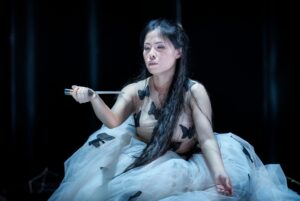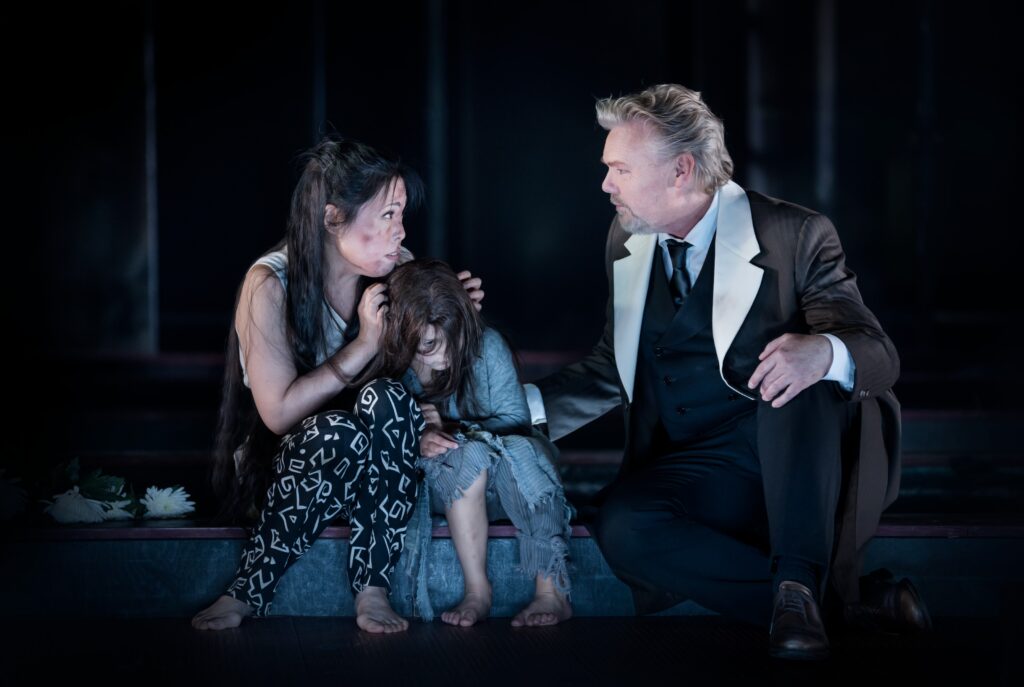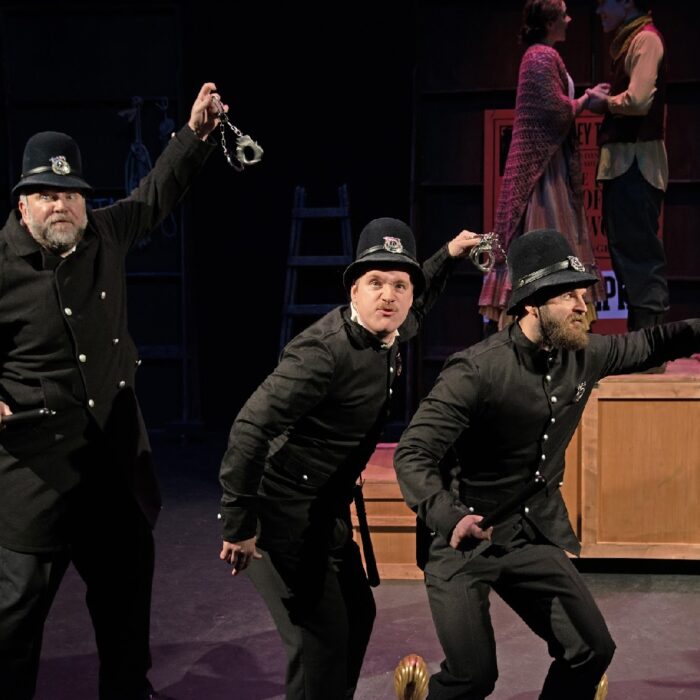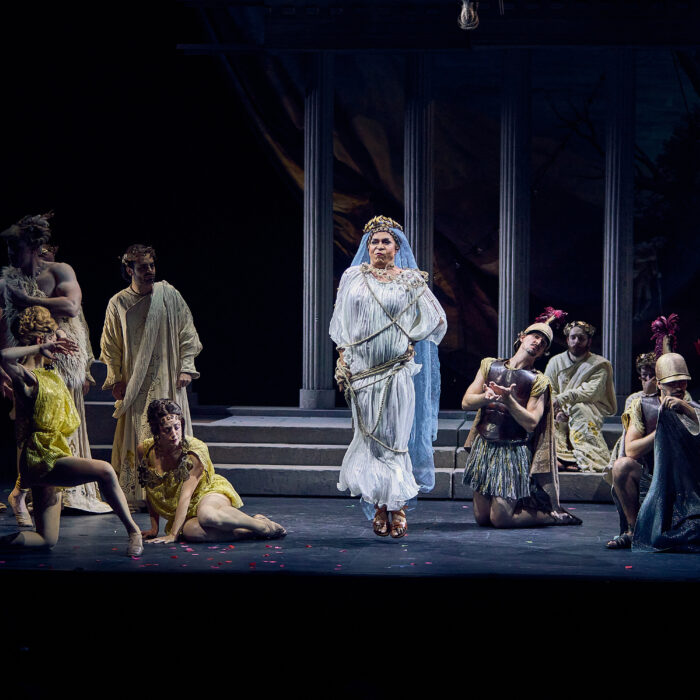
Royal Swedish Opera 2023 Review: Madama Butterfly
Eri Nakamura is a Revelation in Mixed Production by Kirsten Harms
By David Salazar(Credit: Markus Gårder )
This review is for the performance on August 28, 2023.
“Madama Butterfly” is one of opera’s most renowned and controversial stories.
On one hand you have the tale of a young woman waiting endlessly for the man she loves, only to discover that she’s been lied to for the past three years, a fact that the audience is privy to right from the off. This creates a semi-exploitative dynamic with the character. But, then there’s the fact that the work is perhaps the most emblematic example of 19th century exoticism in how it appropriates Japanese culture through a colonial lens. Like the voyeuristic relationship we share with the titular character, our relationship with the culture’s portrayal also becomes a complicated one. The story is impactful and told through some of the greatest music ever written, but given modern context and sensibilities, it could ring somewhat hollow.
This is the challenge presented to any director who takes on the opera. For its production, the Royal Swedish Opera presented a mise-en-scène directed by Kirsten Harms.
A Mixed Bag of a Production
The production seems to bring the opera into a modern setting with the set comprised of a large room. On a large wall stage left is a painting of a cherry blossom tree. Upstage is a back room. Above it, at least at the beginning and ending of the opera, is an awning of sorts through which we initially see Cio-Cio San curled up looking like she might be a refugee. At the end of the opera, Pinkteron arrives via this awning to find Cio-Cio San as she commits sepukku. We also see the Bonze appear here to curse Cio-Cio San.
In the ground at the center of the stage is a staircase that characters use to enter or leave the stage. Like the awning, this staircase is spotlighted at two particularly major moments – when Cio-Cio San first arrives in her wedding gown and when she guides her son away from her, moments before her suicide.
The set is established as living quarters for Pinkerton in the first half. In the first scene he is lounging on a seat, flirting with some women, and entertaining guests. The entire wedding ceremony takes place here and in the second half, when the set becomes Cio-Cio San’s home. We now find holes all over the floor with characters walking along the planks. This sudden shift emphasizes the massive hole (pun intended) in Cio-Cio San’s life. However, what’s fascinating is how the characters interact with this structure. While Cio-Cio San and her son skirt around the planks with ease and flexibility, everyone else looks awkward and ill at ease, often avoiding them as much as possible. When Pinkerton arrives, he steps right onto the planks without any issue. The symbolism of this entire set design couldn’t be more obvious or effective.
Cio-Cio San’s wedding dress also takes on major prominence throughout. The character wears a white dress, holding an umbrella and veil above her. This dress automatically emphasizes the Western wedding and thus how Cio-Cio San will be trapped by the colonial mindset already imposed on her. In the second Act, she throws on the wedding dress when she knows that Pinkerton’s ship has arrived. But now the dress features a myriad of butterfly silhouettes all over, harkening back to the duet where Pinkerton and Cio-Cio San converse about butterflies being trapped. If only the mechanics of the dress itself weren’t as sloppy in that first act… but more on that later.
All of these factors, and the opera’s big ending, lend it more than just a modern veneer. As such, the staging challenges some of the opera’s problems and even confronts them head-on without falling into the trap most modern directors do by ignoring the fact that the libretto exists and that audience members might actually understand Italian and hence what the characters are saying.
Additionally, the production takes a couple of other major risks worth mentioning. The biggest narrative risk (the ending) will be saved for later. The use of the child is another one worth exploring, mainly because of how much time the character spends onstage. Often, directors bringing the child on stage only when absolutely necessary. But here, Cio-Cio San’s son appears throughout the second and third act. The child even plays into some major beats, a lot of them featuring Cio-Cio San holding him tight to her while producing some of her highest notes in the score.
The preponderance of the child comes at the expense of Suzuki’s involvement as a character. She spends less time on stage than in other productions and only seems to be around whenever she has to sing. Rather than a friend of Cio-Cio San’s, she very much feels like a servant here. On one hand, it further isolates Cio-Cio San in the overall context of the story, emphasizing her personal tragedy. However, this also takes away the audience’s surrogate character – the one person that we can identify most with because we see everything the way she sees it. When Suzuki is a firm presence, we understand the tragedy to be more than just one person’s – Suzuki has also lost a friend. But here, that added complexity is completely lost.
Other aspects of the production also fall somewhat short. Despite the overall brilliant staging throughout the second act, the first act feels very rigid and awkward. Given its ceremonial nature, this could be arguably consistent with the dramatic action. There’s a forced wedding and Cio-Cio San is very much an innocent child. But, the stilted nature of the staging makes the characters feel like shells lacking in personality or complexity of any kind. When the Bonze arrives, three martial artists in black also appear to disrupt the events. But they don’t really do much, and so this inclusion feels unduly strange.
The love duet, one of the most sensual (and disturbing) moments in all of opera, felt very odd in its staging. Early on Cio-Cio San has to take off a layer of her wardrobe; soprano Eri Nakamura looked visibly uncomfortable while pulling the layer off around her head as she was singing. Instead, she waited to finish the phrase, all while holding the clothing close to her head for what seemed like an eternity before she took it off. It was not a particularly elegant moment visually for neither the actress or production, bringing attention to the poor design of the wardrobe at a moment where it most certainly wasn’t called for. From there, she throws on a jean jacket she wore in the opening scene for some reason. She’s supposed to take it off later (which she does). This begs the question of why she put it on in the first place. And while one might understand that Butterfly feels rather insecure and uncomfortable during the love scene, Pinkerton being shy doesn’t make much sense either. Perhaps the goal was to add a layer of complexity by having him question his motives and intentions. Unfortunately, that never quite came through and mainly because he doesn’t chase after her but simply plants himself on one side of the stage and watches her flit about.
Finally, a major pet peeve of mine is when the singers lay down for what seems like a love scene and start singing while on their side only to sit up again moments later because a high note is coming and breath support is necessary. One might argue that the staging makes the suggestion, but it ends up coming across as indicative rather than true immersion – the actor (and director) tells the audience that because the singer made this movement and held this position for a few seconds, we are to understand sensuality rather than truly feel it. The magic is lost the moment the singer sits up for mechanical purposes (because there are never narrative reasons for a character to lay down and then sit / stand up again unless for some sort of vocal requirement). “Suspend your disbelief” only takes you so far as an excuse, especially in opera. This particular staging choice has become a cliché of opera directing that simply takes you right out every single time. The Royal Swedish Opera listed the first act as lasting 50 minutes and Acts two and three as 85 minutes in length; the first act felt twice as long as the second act.
Most of the staging in the second act works, thanks to the work by Eri Nakamura (presumably in concert with Harms). But, the bit of staging during the interlude between Acts two and three also doesn’t quite work. As the passage commences and Suzuki falls asleep on the coach, a nude woman appears on stage with only an umbrella and veil “covering” her, and starts walking around the planks. All the way upstage, we witness several navy soldiers gazing at her. It’s an interesting concept that brings to light the exploitation at the core of this opera. But unlike the music which builds exuberantly, the staging doesn’t. The woman continues her trek around the stage with the same measured pace. The soldiers come a bit closer, but do nothing. As an audience member you’re left wondering if this is going anywhere the entire time and when it doesn’t, the frustration only grows as you realize that you just missed out on the gorgeous musical passage because of what ultimately resulted in a staging distraction.

(Credit: Markus Gårder )
A Vibrant Star
While it was hard to ignore the staging mishaps throughout the first act, the second half of the show felt, mostly, like a revelation thanks to the work of its central star – Eri Nakamura.
The Japanese soprano is no stranger to the role, having performed it with the Royal Opera House, Canadian Opera Company, and the New National Theatre Tokyo, among other venues. And on the strength of this performance, she should probably be the go-to in this role for as long as she wants to sing it.
Mind you, it didn’t get off to the smoothest of starts. Like the production itself, she took some time to warm up in Act one. During “Ancora un passo or via,” Nakamura, dressed in a white wedding dress and covering herself with an umbrellaed veil, delivered all the notes and managed a solid legato in the build up to the climactic high B flat on “al richiamo d’amor” without issue. But, the color of her voice was uneven through the registers.
Fortunately, after that, it was, nearly “smooth” sailing for the soprano. Throughout her initial encounter with Pinkerton, she was reserved and shy. Her sound warmed up as she grew more comfortable with him. By the time she got to the duet, Nakamura’s voice was pure and silky in its polish. She flitted about the stage nervously, expressing Cio-Cio San’s corresponding anxiety and fear at this initial encounter, unsure of how to proceed or what was expected of her. Unfortunately, while her singing was pristine throughout, it was difficult to hear at times over tenor Daniel Johansson who blasted his bright tenor over her, particularly at the climax.
But when Act two came along, Nakamura seized control of the audience’s minds, hearts, and attention, never letting go.
From the off, she had a carefree attitude, navigating the stage planks with ease and flexibility. But even early on, we got a sense of this internal conflict between her belief and her deepest fear. What was most compelling about “Un bel dì vedremo” was the mix of hope and dread in the interpretation. The aria is so potent in the context of the opera because it is essentially the starting point for the character. This is the point where her hope is highest and the one from which she will plummet to her doom. As such, the aria itself builds up to an explosive and intense climax that brings together this moment of hope. Nakamura built up to the high B flat at the apex, her voice growing in strength and resolve throughout, particularly from “Tutto questo avverrà” onward. But at the same time, as she sang this climax, she shifted towards a couch on stage left. There was some doubt in her eyes as she sat on the couch and at the delivery of the high B flat, grabbed her sleeping child off the coach and brought it to her chest, grasping for the very hope she was singing about. What made the moment all the more potent was that, at least from my position in the theater, I didn’t even realize her child was there at all until that very moment. Suddenly the entire aria was turned on its head and we could see that despite her optimism, part of Cio-Cio San feared that abandonment might be real. It was a starting point for her to build the rest of the character’s arc.
But first, she had to fight off three different men trying to convince her of this very fear. Goro is looking to continue exploiting her; Yamadori wants to marry her; and Sharpless wants to give her a letter from Pinkerton that confirms her greatest fears. But Cio-Cio San derides the first two by pointing out how things work in America. Nakamura’s voice took on a more delicate and playful quality, all while pushing Yamadori around.
At the close of this scene, as Goro and Yamadori rush off, Nakamura’s Cio-Cio San, seated at the center of the stage could not contain her enjoyment. There was a big smile across her face. Off to stage right, Karl-Magnus Fredriksson’s Sharpless looked on, somewhat stupefied, somewhat confused, his eyes on her the entire time. When Cio-Cio San registered that he was watching her, suddenly her entire expression changed, taking on a more serious complexion. Was it shame? Embarrassment? Or worse – the notion that now they have to return to more serious business? There was something thrilling about this silent moment, a tension that kickstarted the next section and one of the most potent scenes of the entire opera.
“Che tua madre dovrà, prenderti in braccio” is not as renowned a passage as “Un bel dì” or the opera’s final scene, and understandably so. But, it is at the heart of this opera’s tragedy – Cio-Cio San narrating to her child the potential future of the two alone and abandoned, forced to wander the streets begging for help. Opening with a thread-like pianissimo, Nakamura sang through the passage, the resolve of “Un bel dì” transformed into an anxious quality, the vibrato more rapid, her voice weeping throughout the passage. Then at the peak of the aria, her voice exploded with intensity as she declared “Piuttosto la mia vita vo’ troncar! Ah! Morta!” Here, she held out the high A flat as long as she could, a pained cry of desperation to cap off the most unforgettable rendition of this aria that I have ever heard live. At this point, she grabbed the child again, holding him close to her.
This proved a turning point from which the character seemingly could not recover and during an ensuing scene with Yamadori, Nakamura’s Cio-Cio San ragdolled him to a sofa and then to the ground. The fury and intensity of the character was on full display, her voice aggressive and jagged.
Only when the canon sounded did we get a sense of that early hope. But first, the audience was forced to wait as a phone went off at the very moment the canon ended. The music stopped and for what seemed like an eternity (it was likely 30 seconds or sound), the entire auditorium was silent, save for the ringing cell phone. Tension built as it became clear that the music would not continue until the audience membered silenced his / her phone (something requested at the beginning of the show). All the while, Nakamura kneeled on stage, her eyes staring into the distance, readying herself to approach. Once the music restarted, she stood up and started walking toward the front of the stage, softly singing “Bianca…bianca…il vessillo, americano delle stelle…” over a reprisal of “Un bel dì vedremo’s” melody. Each enunciation of “Il nome” gained in intensity, her voice growing and growing all the way up to the climactic high A on “Ei torna e m’ama!” Once again, she extended that note as long as she could, delaying the explosion that would engulf us with the brief reprisal of the love duet’s main theme. But most impactful still, was the physicality of this entire scene. After the anguished conversation with Sharpless and the anger at Goro, Nakamura’s Cio-Cio San suddenly looked spent. But, as she ambled toward the front of the stage to read out the name of the ship, her physicality shifted, her strength returned, coalescing with the vocal intensity and the extended high note. But when she finished the passage, she suddenly exploded into tears – as if the emotional roller coaster was already too much to bear. At the start of the ensuing flower duet, Nakamura’s Cio-Cio San wiped off the tears as she settled herself, her voice more delicate and gentle during the duet with Suzuki. Given the context of what we had just witnessed, Cio-Cio San suddenly recovering herself at the start of the more gentle flower duet after being revindicated was a perfect emotional and musical sense.
It also set us up for a devastating finish. Cio-Cio San doesn’t kick things off at the start of Act three but is left in a perpetual state of waiting. In this production, the character is relegated to the background where we see her pacing around a back room with her son. The child falls asleep, but she continues the pacing until eventually collapsing. We watch the rest of the action unfold but our attention remains with her the entire time.
Once she returns onstage, seemingly refueled and full of the initial energy from the start of Act two, the downward spiral was all the more visceral in its impact. When she sees that he isn’t there and everyone else around her is silent, Nakamura’s Cio-Cio San’s face went from wildly excited to paralyzed with dread, leaving us waiting for her to notice Pinkerton’s wife at the far end of the stage. The tension built as we waited for that moment to happen, or not. But when she saw her, Nakamura’s entire energy and demeanor shifted into an aggressive rigidity.
From there she ordered everyone out while trying to sustain composure, turning away from Kate and Sharpless, trying her best to hide the gut-punch she was experiencing, and her voice trying to retain fullness and strength. When finally alone with Suzuki, the percussion took over. Nakamura’s Cio-Cio San let out a soul-crushing, guttural cry; I doubt anyone in that hall was not broken or emotionally destroyed at that moment from the intensity of the suffering. Under intense laments, she begged Suzuki to leave, but before her servant exited, Nakamura’s Cio-Cio San jumped up, rushed to her, and hugged her one last time before letting her leave. She then grabbed the knife and uttered the famed words, “Con onor muore chi non può serbar vita con onore” with a dry monotone that emphasized the fact that she already felt dead.
But, of course, her child runs in at this point. Nakamura’s Cio-Cio San didn’t initially see him blindside her but immediately pivoted, knife in hand, sticking it out in defense, scaring her child in the process. Seeing her mistake, she rushed to him and, for the last time, held him to her,”Tu? tu? tu? tu?” As the aria progressed and destiny approached, Nakamura’s Cio-Cio San held the child tighter and tighter, allowing us to feel the pain, the defeat and the loss. Her voice climaxed to new heights on each phrase and the rubati extended to match Cio-Cio San’s own struggle to let go. In most performances that I have seen, sopranos have already exhausted themselves getting to this point and they must rely heavily on vocal emoting to get through it. Nakamura, who seemed to sound fresher as the night went on was more than up to the vocal demands, her voice soaring over the intense and heavy orchestra with greater intensity, each top note fuller and more potent.
With the final aria complete, Nakamura delivered what proved to be Harms’ greatest directorial coup.
Cio-Cio San directs the child to leave, and he runs down the stairs. Once out of sight, she returns to the knife and picks it back up. The musical accents were coordinated with her unsheathing of the knife and other movements and actions. But she doesn’t kill herself immediately and seems to struggle with the decision for a prolonged moment, the music moving closer and closer to the ending we are all so familiar with. In fact, it got to a moment where she dragged it out so long that a thought started entering my mind. But then she seemed ready and then: “Butterfly! Butterfly! Butterfly!”
Nakamura’s Cio-Cio San stopped. She listened to Pinkerton’s cries with a smile materializing on her face. And the thought that had been creeping in my mind a few moments earlier took over – is this production really going to do the unthinkable? He rushed onstage via the awning that we first saw her on. She turned to face him and for a moment it seems like the opera was going to give us the ultimate cognitive dissonance. But, no.
As the fate theme thunders out, Cio-Cio San, her eyes locked on Pinkerton, buries the knife. This ending alone made up for a lot of the production’s other shortcomings and seemingly unfinished ideas from the first act, giving us a moment so full of tension and drama that it felt like a revelation. Most of the time, Pinkerton’s calls to Cio-Cio San feel like an afterthought, an unconvincing final attempt to add to what is already a tragic ending. It means nothing for Cio-Cio San because she is dead and doesn’t know that he is coming for her. As a result, it doesn’t add much for the audience. But for her to actually see him and know that he’s come back to see her, giving her one last chance to change her fate and realize her dream, and still decide that it will ultimately mean nothing in the end is the true tragedy. It’s also a moment that empowers her because she is able to look him in the eyes and make him see her strength and resolve. I don’t think I ever want to see the ending of the opera any other way, but I also don’t think the tension and intensity I felt during this experience will ever be replicated.
Not Quite There
A strong Cio-Cio San is all you really need throughout the night, for the most part.
Next to Nakamura, baritone Karl-Magnus Fredriksson was undeniably the other standout. His voice, round and full, matched with a physical sturdiness. And nowhere did he shine quite as effusively as he did in this scene. You could sense Fredriksson’s reticence to tell Cio-Cio San the truth as he shifted his gaze from her constantly, searching for the right words. Even in more forceful moments, such as when he demands and she accepts Yamadori’s proposal, there was a plaintive quality in his singing, as if he were begging her. As she admits what her fate might look like without Pinkerton, his rigid and firm demeanor shifts toward something more gentle. He sits beside her and the child seeking to comfort her. This is perhaps the only time I have ever felt reminded of the Germont-Violetta scene from “La Traviata,” while watching this scene. Where most Sharpless are conflicted, Fredriksson aims to do something about it by consoling Cio-Cio San and her child in a moment that one could only see as fatherly affection. This added to the tragedy of the moment and the pain felt by all. When he returned later in the act, alongside Pinkerton, his voice was full and potent. The reversal of his demeanor again reminded me of the big concertato in “La Traviata.” Moreover, Fredriksson’s take on this scene weakened Pinkerton in the moment, lending a greater level of credibility to “Addio fiorito asil” and his sudden sense of guilt.
As Pinkerton, Daniel Johansson displayed a robust squilo sound throughout. Unfortunately, his singing rarely shifted away from this trumpet-like approach and lacked much in flexibility and color. While his tenor produced some thrilling high notes – the high A on “Niente bonzeria” in Act one, the high B flat at the apex of “Addio Fiorito Asil,” or the impassioned final three “Butterfly,” it led to a massive mismatch with Nakamura during the love duet. One might be included to argue that Pinkerton, overpowering Cio-Cio San vocally in this scene, matches up with the overall dramatic idea. But, the score has their lines overlapping and dovetailing one another all the way up to the climactic high C. I doubt Puccini would have written that if he wanted audiences to hear one singer more than the other. It shouldn’t sound like a vocal struggle but a moment of emotional and musical unity.
That said, he did manage a fine rendition of “Addio fiorito asil.” His legato line was smooth and impassioned, building all the way up to the climactic “son vil” while standing in one of the holes around the stage. At the apex of the aria (and in another lamentable piece of staging), Kate walks over to console him, which prompted him to swat her away like a fly. Despite this, Johansson was able to imbue the character with a sense of weakness and guilt that made him both pathetic and empathetic. When he appears at the end to “save her,” the moment took on an even greater complexity because Pinkerton’s descent to a man of complete and utter weakness was complete. He initiates it with all the power and in the end, all he can do is stand and watch as his calls to Cio-Cio San mean nothing.
As Suzuki, Johanna Rudström’s mezzo meshed well with Nakamura during the flower duet. However, there were moments where her lower range was rather soft and lacking. Meanwhile, Ebba Lejonclou as Kate Pinkerton got an expanded role as she was allowed to interact with the child in attempts to win him over. Her struggle to gain his affection as he swatted her away was notable and added to our empathy for the character; when Pinkerton swats her away the same way the child does, you got a glimpse into the tragedy that a potential sequel would hold for this new family. Niklas Björling Rygert had an initially imposing figure as Goro, matched by a sturdy sound. However, seeing him ragdolled by Nakamura was undeniably one of the most enjoyable moments of the scene because it revealed her strength and exposed his cowardice to tremendous effect.
In the pit, Constantin Trinks delivered a sublime rendition of Puccini’s familiar score. In the small hall, the orchestra sounded titanic in its sound. The strings were always lush, the winds bright, and the brass round but balanced. He had the ensemble play with abandon, but absolute control so that every detail was heard and never stuck out oddly. The first notes are a perfect example. One could feel the intense pressure of the bows on the strings during the opening fugue, but it never sounded coarse. The peaks of volume could overpower some of the singers at times, but Trinks adjusted almost instantly to allow the voices their prominence. Props must also be given to him for the patience exhibited while the audience member’s phone rang in the hall. For the singers to lose focus during this moment is one thing, but no doubt the conductor, who has to guide the momentum of the entire moment, could easily lose his flow when such an interruption takes over. The fact he held his nerve and then continued without any incident speaks to the absolute control he displayed throughout the night.
In all, this “Butterfly” was all about Nakamura and her artistic genius that flourished more and more as the night developed. She is the reason to see this opera.


